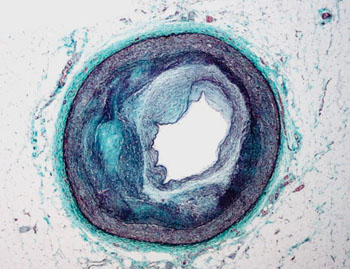Blood Test Influences Clinical Decisions in Coronary Artery Disease
By LabMedica International staff writers
Posted on 23 Apr 2015
Clinicians need better approaches to evaluating women at midlife and beyond who present to primary care with chest pain and related symptoms such as an individual's current likelihood of having obstructive coronary artery disease. Posted on 23 Apr 2015
A blood test that incorporates age, sex, and gene expression, influences medical decision-making in the evaluation of non-diabetic women presenting with non-acute typical or atypical symptoms, suggestive of obstructive coronary artery disease (CAD).

Image: Histopathology of a coronary artery with the most common form of obstructive coronary artery disease (atherosclerosis) and marked luminal narrowing (Photo courtesy of Nephron).
Scientists at the New York University School of Medicine (NY, USA) and their colleagues studied 320 women presenting to 16 primary care providers across nine practice sites and six states in the USA. The enrollees presented with stable symptoms suggestive of obstructive CAD and undergoing age/sex/gene expression score (ASGES) testing from the primary care providers in geographically diverse sites. The mean participant age was 57.8 years and the ASGES scores were pooled.
The investigators used the Corus CAD test (CardioDx; Redwood City, CA, USA). The Corus CAD test is the first and only commercially available blood test that can safely and conveniently help primary care clinicians and cardiologists assess whether or not a stable non-diabetic patient's symptoms may be due to obstructive coronary artery disease. The study indicated that women with low Corus CAD test scores of less than 15 were significantly less likely to be referred for further cardiac evaluation by their primary care clinicians within 45 days of follow-up.
The mean Corus CAD test score was 10.3 ± 8.2, with a range of 1, corresponding to a 1% likelihood of obstructive CAD to 38 corresponding to a 62% likelihood of obstructive CAD. Overall, 77.5% of women (248/320) had low Corus CAD test scores. The referral rate for further cardiac evaluation was 4% (10/248) among women with low Corus CAD test scores versus 83.3% (60/72) among women with elevated scores.
Joseph A. Ladapo, MD, PhD, the lead author of the study said, “Current testing approaches for identifying obstructive CAD have been shown to be less accurate in women than men, and these diagnostic challenges lead to both over-testing of low-risk women and under-testing of high-risk women. This study demonstrates that incorporating the age, sex, and gene expression score early in the diagnostic pathway, as a part of the patient's clinical assessment, can help clinicians rule-out obstructive CAD in menopausal women presenting with chest pain and other angina symptoms.” The study was published online on April 6, 2015, in the journal Menopause: The Journal of The North American Menopause Society.
Related Links:
New York University School of Medicine
CardioDx













